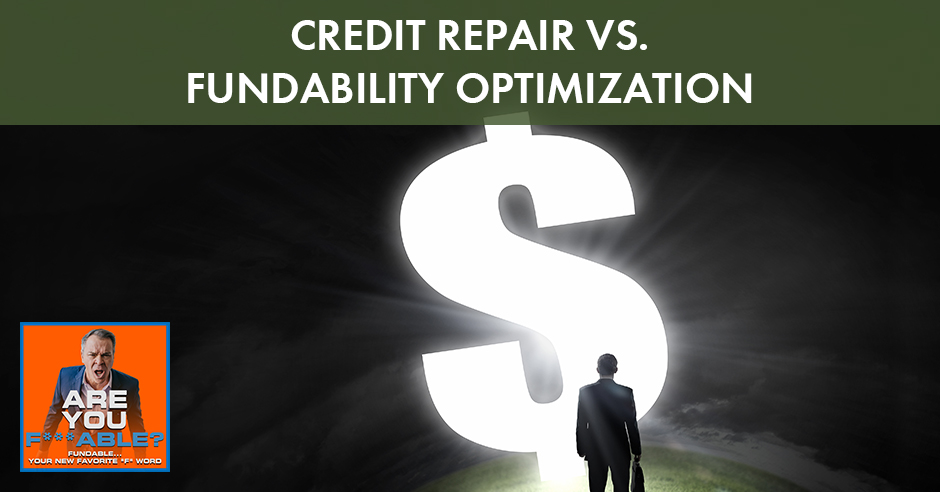
You may think that credit repair is necessary for your tarnished credit profile, but it is not always the case. In this episode, Merrill Chandler explains why credit repair is not a promising option to make for your credit profile. He reviews some details to watch out for and how to protect yourself from them. Going to the better option, Merrill sheds light on fundability™ optimization and what it can do for you. On today’s show, learn more about holistic approaches that can guide you towards optimizing your funds.
—
Watch the episode here:
Listen to the podcast here:
Credit Repair Vs. Fundability™ Optimization
Fundability™ Optimization Versus Credit Repair
In this episode, I decided to pull out all the stops and went back into some of my archives because I was getting ready to do a new episode on the difference between credit optimization, fundability™ optimization and credit repair. When I went through this, there was so much valuable content. I didn’t want you to miss any of this. While it may not be as polished in its format, you are going to love the deep dive that I do. We’re literally scuba diving into the credit repair. The few strengths that it has and all of the things to watch out for. It’s like a cautionary tale. This is an episode of me reviewing all of the details of credit repair, what to watch out for, how to protect yourself and what fundability™ optimization can do for you and knock it out of the park.
—
We’re going to be talking about fundability™ optimization and credit repair. Remember, in the previous episodes, we’ve discussed it significantly my history with Lexington and my history of fifteen years of pure credit repair expertise as it were. I help cofound numerous credit repair companies around the country, but my dissatisfaction with credit repair is what brought us to the end game when I was in prison. I had the epiphany about what did it take for individuals to become fundable, to get the money that they need, to qualify for the loans that they were going to need. The difference between fundability™ optimization and credit repair is the difference between a Lexus 2019 and a horse and buggy.
A horse and buggy is quaint. It’s a delightful little something to take your date on but if you need to get somewhere, it’s not going to take you there. It will take you across town if you live in a village. The Amish swear by them. I’ve got nothing against them. I’m just saying, “What are your goals and what are you trying to accomplish? Whatever you’re trying to accomplish, you’ve got to have the tools that are going to match those goals.” Fundability™ optimization is a set of tools that allow you to create the most and fastest delivery vehicle to create your fundability™. What’s the essence of credit repair? They write disputes letters to credit bureaus and literally and hope something is deleted because there’s no power. No credit repair company has any power over the results of those disputes. I have not met a credit repair firm yet.
Whatever you're trying to accomplish, have the tools that are going to match your goals #GetFundable Share on XI started a bunch of them and I have coached a bunch of them. There are no legitimate FICO-based credit building strategies that are available there. What they do is they will say, “You need to get a credit card.” They send you to a link that gives them a payoff for recommending it. If you go to any best credit cards in the country, usually among the top ten, six to eight of them will all be less than viable credit instruments based on the tiers and the values. We’ve already talked about the quality of your profile determines your fundability™, whether or not someone’s going to get you the types of instruments that you want. You have to have the right instruments. No credit repair company that I’ve ever met bases their recommendation on the viability of the credit card they recommend and how it will build a fundable profile. They all do it including Lexington Law. They all send you to places who pay the most money for the credit card referral. Buyer beware.
We will be going in our liars, cheaters and thieves because in this series of episodes, we’re going to be talking on all of the myths, all of the different ways that people use language in this business to take advantage of your ignorance and your innocence. I said in previous episodes, I’m done with that. We’re laying it on the line. Interest first in all of our episodes. There will be episodes called Liars, Cheaters and Thieves. We’ll be going over websites right here that reviewing exactly how this will look. The next thing we need to understand is that credit repair does not help people with good credit. By good credit, we mean credit where you do not have derogatory accounts. You don’t have bankruptcies, collections, late pay, all those things. Good credit doesn’t mean fundable credit. Good credit means the absence of derogatory accounts. You’re going to learn in the next few episodes, a derogatory account is one type of bad credit but negative indicators are another type of bad credit. You’re going to learn so many things that are going to help your day-to-day and the very decisions you need to make as we grow.
You cannot repair your way to a fundable 800-plus profile. You can’t do it. A fundable profile is proactive steps that are helping you create credibility with the lender software. Fundable means that an underwriter software or real-life person will check it off and say, “I’m going to give you money.” That’s what fundable means. Good credit doesn’t mean anything. Bad credit doesn’t mean anything. Those don’t mean anything in the real world of lenders and lending. I did bring up Lexington. On their website, I wanted to say they advertise that they have helped literally tons and tons of people remove derogatory accounts from their credit profile. Notice it’s 24% of what they went after. That means if you go after ten items, you’re going to get 2.5-ish. I found that out on my own.

Fundability™ Optimization: Good credit doesn’t mean fundable credit. Good credit means the absence of derogatory accounts.
When I left Lexington and when I started my own credit repair law firm, I tried to go deeper and deeper into the credit repair process and before I had my prison epiphany, I found that you can’t make somebody fundable by getting rid of negative items. You have to build an entire fundable profile even above your credit report and your credit profile. We call it a borrower profile. It’s all of the things that lenders take into account. I know the credit repair space and I developed fundability™ optimization so that we could make you fundable, so that you can create those very same things. If you have derogatory accounts and all you want is to remove those derogatory accounts, then find somebody that you trust to be able to review that.
What To Look For In Credit Repair
Let’s go over a couple of things of what to look for if you’re looking for credit repair. First of all, do they guarantee their results? If they guarantee their results, run away because nobody can guarantee the removal of derogatory items except in one illegal and illicit way. There’s what’s called e-OSCARs. It is literally hacking the system, not legally, not morally, not ethically. e-OSCAR is a terminal point for the credit bureaus and they give these e-OSCARs terminals to mortgage brokers and subscribers, people who subscribe to the credit reporting services. If you have an e-OSCARs and I happen to be a person of ill repute, then I may go to the side and say, “Frank, I can delete all your negative items and then go into e-OSCARs and delete all the negative items.”
Two things are going to happen. First, the guy who’s saying that is going to be fired and/or prosecuted because it only lasts so long and bureaus know about this. Their artificial intelligence software finds the leakage of where certain e-OSCAR terminals are getting rid of too many or a lot of deletions from one e-OSCARS. They’ve got the metrics on all of that. Secondly, and most importantly, it’s only going to last for a minute. I’ve seen it happen over and over and people will come to me like, “I’ve got this guy who says he can guarantee in fifteen days removal of all my stuff.” I say, “Runaway, no joke.” Not because I want you to go to me or anywhere else. I’m saying that that is fraud. That is prosecutable.
The quality of your profile determines your fundability™ #GetFundable Share on XI know guys in California, in New York and in Florida who have promoted that and thought they could get away with it and did jail time. I’ve been to jail but I haven’t been to jail for fraud. I didn’t go to jail for stealing somebody else’s proprietary technology. I went to jail for being stupid about my own health and well-being and those around me. I don’t fault them for going to jail. I do tell you to take care of yourself and make sure that you never mess around with somebody who guarantees removal. If they say, “Guarantee removal or your money back,” then also be wary because what they’re going to say is, “Read the fine print.” Some people will say, “We guarantee six deletions out of the ten. If they don’t, then we’ll charge your account back.” There are a lot of ways.
I’ve been doing this for years and there is some gnarly stuff out there. When I said we’ve formed Lexington Law because it was the Wild, Wild West, while we were at Lexington, all 38 states and the federal government came up with laws to regulate credit repair because people were being ripped off. No one knows what else to do so they go to a credit repair company who guarantees the removal. Buyer beware, this is not a thing. You’ve got to be careful. No guarantees. You also want to check for individuals who say that they can do X amount in a certain time period. The vast majority of credit repair firms, if they ask for significant money upfront, most of them fall within the Credit Repair Act and they are charging $79, $99, $129 a month.
Here’s the problem. They’re getting paid when you give them money every single month. They’re charging your account let’s say $99. What’s happening is they have to do something for that $99. The only arrow in their quiver is to do another credit repair round. What most people don’t know is that there’s what’s called the coated period at credit bureaus. The coated period says that if something has been verified as accurate, then after 90 days even up to six months, the second you go after that account again, they’re going to say, “Verified as accurate.” They’re going to send you a letter that says, “Stop bugging us because this is now fraudulent. You keep asking us to take off this thing and we verified it as accurate.” Credit repair companies to get paid by you have to do something.

Fundability™ Optimization: The vast majority of credit repair people have no idea of the FICO 40.
That’s the credit repair laws. It dictates that something has to be done to earn that $99 a month. They’re going to do another round of disputes. It’s not sophisticated. Everything’s a nail and they’re a hammer. The bottom line is credit repair is a limited, highly suspect for most organizations, even for the legitimate organizations who proven up, been around for years and years. It’s not very efficient. One other negative that comes with credit repair is do you realize, this is straight from FICO, that a 30-day late on a closed account that is twenty years old, if you delete that account, your score will go down. The negative indicator is less valuable than the high-value account of having a previous twenty-year account that was positive.
You’ve got to evaluate what you’re doing. I call it scorched Earth is what credit repair does. If there’s a negative, they try to delete it and sometimes they’re harming your profile. With me, our clients, we evaluate the positive contribution of that twenty-year-old account. We evaluate the contribution of every one of your derogs. We may not want to remove one or two of them and let them timeout. By timing out means coming off naturally off the report. There are many layers to this and it can be very complex. If you don’t know what you’re doing, the credit repair guy doesn’t know what they’re doing. They write letters and do deals because they found a marketing scheme that people will respond to them. They get a few results and they can put those results on their credit repair websites and deceive even more people.
Holistic Approach
The truth is that you need a holistic approach. That’s why we started this blog. We’ve only given all this tech to our high-net-worth, full-service clients. We’re putting it out there and you’re going to know it all. Nothing withheld. This is one of the biggest landmines that you can step on is going to a credit repair firm and then having them ruin your profile because they tried to delete everything. Here’s another negative about credit repair. Let’s say you have a collection across all three credit bureaus. If you take the collection off of one or two of those but it’s on the third, it shows up when you pull a three-bureau report, like a mortgage or a business line of credit or otherwise. If they pull all three bureaus, you didn’t buy anything by getting it off of two reports.
Credit repair does not help people with good credit #GetFundable Share on XYou’re going to create a greater range. The difference in score between your highest and your lowest is your credit score range. While we tell you that credit scores are the third or fourth most important metric that’s being measured, it still is the third or fourth most important. We will refer to scores as they represent the quality of your profile. If you have a low range, that’s one more way to stay in automatic underwriting. We want to make sure that that range is as small as possible because that keeps you in automatic underwriting because the data is trustworthy. If the scores within five or ten points of each other, that means the data is being reported carefully. If you delete a collection or a bankruptcy or any derogatory count off of one and not all three, then your range increases. No matter what happens, you’re going to be kicked out into manual underwriting because they don’t have a clue why your score is so different. They’ve got to go find out why. Once you’re in a manual underwriting, you’re taking a hit every single time. You’re going to have problems.
Those are the things to watch out about credit repair. I’m sure we’re going to have a full-blown credit repair episode. I talk about my roots and where I came from but the vantage point of being able to stand on the mountain peak that I’m looking at and look back is that I see all the problems. I have no problem with profit motive but I do have a problem with not telling the truth to your customers or clients. The truth is that the vast majority of credit repair people have no idea of the FICO 40, no idea of what a FICO and automatic underwriting software is measuring so they try to delete. All of us have a friend who has done credit repair and every one of us know that they don’t always come off of all three bureaus. The clean sweep is rare. You have to then suffer through manual underwriting if you’re more than twenty points or so. Be careful. I wanted to stop and talk about credit repair before we went to how fundability™ optimization works. We’re going to hit the next subject and I promise, you will not be disappointed as you create more and more awareness about how to frame your fundability™.




